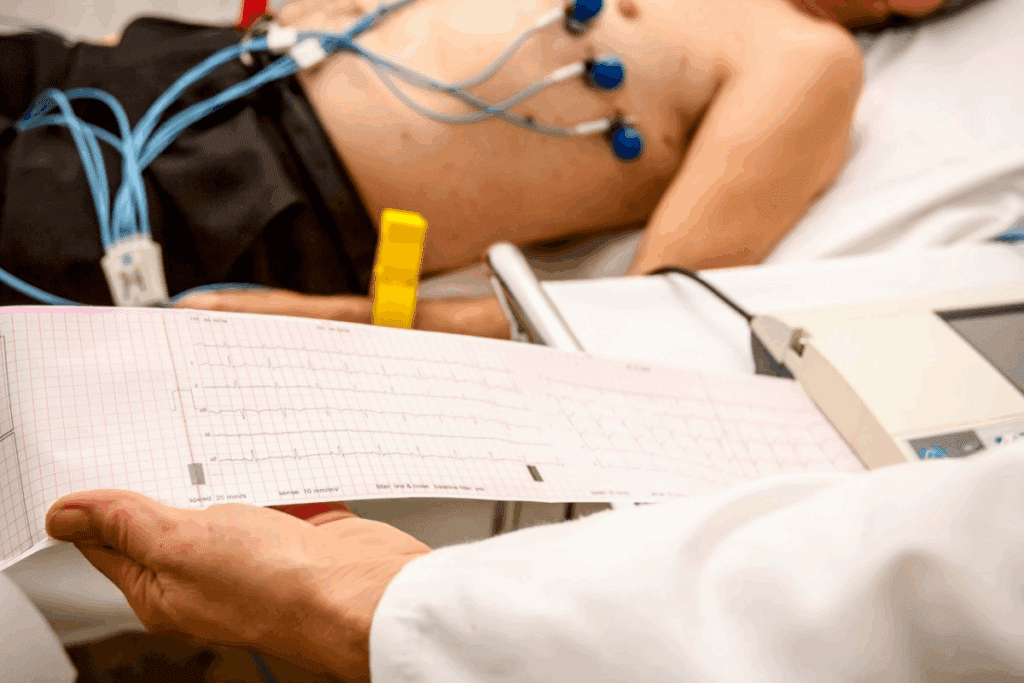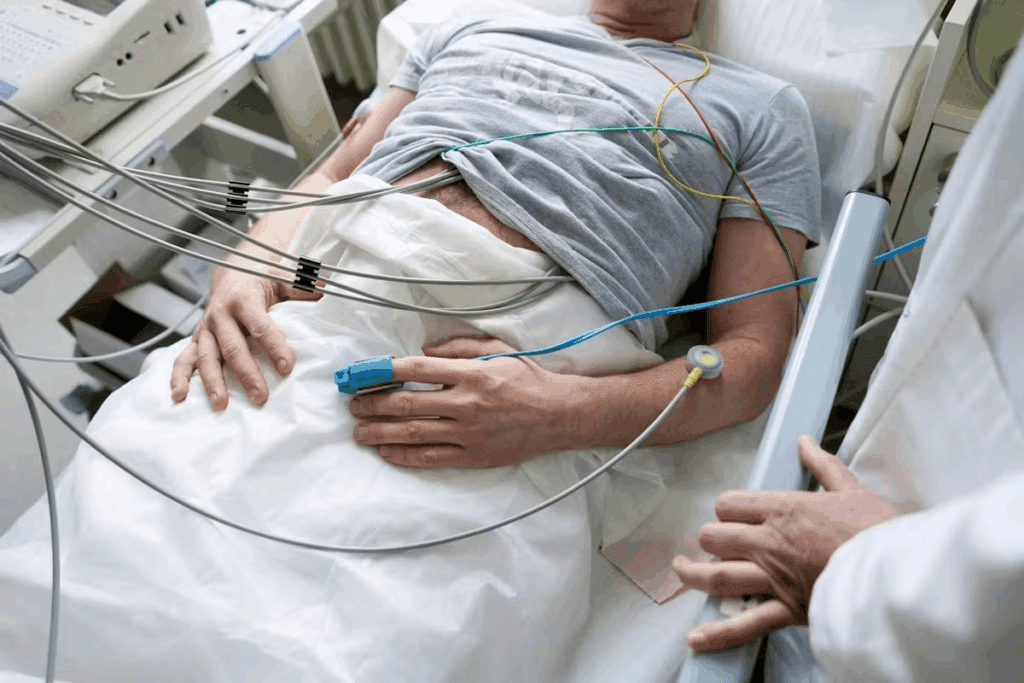Last Updated on November 25, 2025 by Ugurkan Demir

At Liv Hospital, we know that an enlarged heart, or cardiomegaly, needs a detailed treatment plan. Our aim is to give patients the best care that tackles the heart’s problems.
We think managing cardiomegaly is about using medications, surgery, and healthy lifestyle changes. By focusing on the main causes and using a wide approach, patients can see big improvements.
We’re dedicated to new ideas, top-notch care, and putting patients first in our cardiomegaly treatment plans. We aim to offer the best healthcare that fits each patient’s needs.

The term cardiomegaly means the heart gets bigger because of different reasons. This can happen when the heart muscle works too hard. If not treated, it can cause serious problems.
Cardiomegaly, or an enlarged heart, is not a disease itself. It’s a sign of a problem that needs doctor’s care. There are several types, like:
Knowing these types helps doctors find the right treatment.
Many things can cause cardiomegaly, such as:
Finding out why the heart is enlarged is key to managing it well.
Symptoms of cardiomegaly can be different but often include:
Spotting these symptoms early can help doctors treat it sooner and improve results.

Figuring out if your heart is enlarged is key to finding the right treatment. Knowing the cause and how severe it is helps us plan the best course of action.
There are many tests to find out if your heart is enlarged. These tests check how well your heart works and what might be causing it to grow too big.
An electrocardiogram (EKG) is often one of the first tests for heart health. It can’t directly say if your heart is enlarged. But, it might show signs that suggest it could be.
For example, if the EKG shows left ventricular hypertrophy, it might mean there’s a problem that could lead to an enlarged heart. But, an EKG alone isn’t enough to confirm an enlarged heart.
An echocardiogram is the top choice for finding out if your heart is enlarged. It uses sound waves to make detailed pictures of your heart. This lets us see how big it is and how well it’s working.
With an echocardiogram, we can:
This info is key to confirming if your heart is enlarged and what might be causing it.
Even with an echocardiogram, more tests might be needed to fully check your heart. These could include:
These extra tests help us get a full picture of your heart’s health. This lets us make a treatment plan that’s just right for you.
Cardiomegaly treatment must be tailored to the individual. It considers the underlying causes and specific patient needs. This personalized approach is key for effective management and improving patient outcomes.
Treating the underlying causes of cardiomegaly is essential. Identifying and addressing the root cause is vital for a targeted treatment plan. For example, if cardiomegaly is caused by hypertension, managing blood pressure is critical.
By addressing these causes, we can potentially reverse or halt cardiomegaly’s progression.
The primary goals of cardiomegaly treatment include reducing heart size, improving function, and alleviating symptoms. Effective treatment can lead to a better quality of life and reduced risk of complications.
“The goal of treatment is to improve the heart’s ability to pump blood effectively, reduce symptoms, and enhance overall patient well-being.”
Cardiology Guidelines
Expected outcomes vary based on the cause and extent of heart enlargement. Regular monitoring and treatment plan adjustments are essential for optimal results.
Creating a personalized treatment plan involves a thorough assessment. A multidisciplinary team of healthcare professionals works together. They develop a tailored plan that may include medications, lifestyle modifications, and surgical interventions.
A personalized treatment plan is dynamic. It may need to be adjusted over time based on the patient’s response and changing needs.
Medications play a key role in treating cardiomegaly. They help ease symptoms and boost heart function. The goal is to tackle the heart’s enlargement, manage symptoms, and prevent more problems.
Diuretics help get rid of extra fluid in the body, a big issue for those with cardiomegaly. They reduce fluid buildup, easing symptoms like shortness of breath and swelling. Loop diuretics, like furosemide, are often used because they work well.
Beta-blockers are vital in treating cardiomegaly. They slow the heart rate and reduce its force, easing the heart’s workload. This can improve heart function and lower the risk of damage. Metoprolol and carvedilol are common beta-blockers for this condition.
ACE inhibitors and ARBs help manage high blood pressure and ease heart strain. They relax blood vessels, making it easier for the heart to pump. This can slow heart failure and improve survival chances. Lisinopril is a top ACE inhibitor, and losartan is a common ARB.
Anti-arrhythmic medications control irregular heartbeats, a common problem in cardiomegaly. They stabilize the heart’s rhythm, reducing serious arrhythmia risks. Amiodarone is a strong anti-arrhythmic often used when other treatments fail.
| Medication Class | Primary Use | Examples |
| Diuretics | Fluid management | Furosemide |
| Beta-Blockers | Reducing heart workload | Metoprolol, Carvedilol |
| ACE Inhibitors | Blood pressure control | Lisinopril |
| ARBs | Blood pressure control | Losartan |
| Anti-Arrhythmic | Managing arrhythmias | Amiodarone |
In summary, medication therapy is key in treating cardiomegaly. It offers various options to manage symptoms, address causes, and enhance life quality. Understanding these medications helps healthcare providers create personalized treatment plans.
Cardiomegaly treatment often includes many steps. This includes surgery and devices to keep the heart healthy. For some, these steps are key to managing the condition well.
Pacemakers and Implantable Cardioverter-Defibrillators (ICDs) are vital for heart health in cardiomegaly patients. Pacemakers keep the heart’s rhythm steady. ICDs stop sudden cardiac death by shocking the heart when needed.
These devices help those with abnormal heart rhythms or at risk of dangerous arrhythmias. The choice to use a pacemaker or ICD depends on the patient’s health and heart condition.
Heart valve issues are common in cardiomegaly patients. Surgery may be needed to fix or replace damaged valves. Heart valve surgery can greatly improve heart function and life quality.
The surgery type depends on the valve and the problem. Repairing the valve is often chosen first. It keeps the patient’s own tissue and avoids long-term blood thinners.
For cardiomegaly caused by coronary artery disease, CABG is sometimes recommended. This surgery bypasses blocked or narrowed arteries to improve heart blood flow.
CABG can reduce symptoms like angina and improve heart function. It’s considered for those who haven’t improved with other treatments.
In severe cardiomegaly where other treatments fail, heart transplantation is an option. This major surgery replaces the diseased heart with a healthy one.
Heart transplantation is a complex process. It requires careful evaluation and selection of candidates. It gives a second chance at life for those with severe heart disease.
A well-planned diet is key for those with cardiomegaly. It helps ease symptoms and boosts heart function. Making dietary changes is vital for managing the condition and improving heart health.
Dietary changes are not just helpful; they are essential for treating cardiomegaly. By making specific dietary adjustments, people can greatly impact their condition. This reduces the risk of complications and improves their quality of life.
For cardiomegaly patients, a low-sodium diet is a must. High sodium can cause fluid retention, making the heart work harder. Reducing sodium intake helps manage fluid balance and blood pressure.
The American Heart Association advises a diet with less than 2,300 milligrams of sodium daily. A low-sodium diet requires careful planning but greatly benefits heart health.
“The key to a successful low-sodium diet is being mindful of the foods you eat and choosing options that are naturally low in sodium.”
Reducing sodium is just the start. Adopting a heart-healthy eating pattern is also vital. This means eating a variety of foods rich in nutrients and low in unhealthy fats, added sugars, and sodium.
| Food Group | Recommended Foods | Benefits |
| Fruits and Vegetables | Berries, leafy greens, citrus fruits | Rich in vitamins, minerals, and antioxidants |
| Whole Grains | Oatmeal, brown rice, quinoa | High in fiber, helps lower cholesterol |
| Protein Sources | Lean meats, fish, legumes | Low in saturated fats, high in omega-3 fatty acids |
Managing fluid intake is also key for cardiomegaly patients. Drinking enough water is important, as not drinking enough can cause dehydration. This makes the heart work harder.
But drinking too much can lead to fluid overload, worsening symptoms. Monitoring fluid intake and adjusting it as needed is critical.
By making these dietary changes, people with cardiomegaly can better manage their condition. They can reduce symptoms and improve their heart health. It’s about making informed choices and working with healthcare providers to create a personalized diet plan.
Exercise therapy is key in managing cardiomegaly. It strengthens the heart and boosts overall health. Understanding its benefits and guidelines is vital, as it complements other treatments for cardiomegaly.
Cardiac rehabilitation programs are vital for cardiomegaly patients. They help people recover from heart issues and improve their heart health. Our programs are customized for each patient, combining exercise, heart-healthy education, and stress counseling.
“Cardiac rehabilitation is a medically supervised program,” say healthcare experts. “It helps improve heart health and lower future heart risks.” These programs are held in hospitals or clinics, led by a team of experts.
Exercising safely with cardiomegaly is a top priority. Always talk to your doctor before starting any exercise. Safe guidelines include starting slow, watching heart rate and blood pressure, and avoiding too much strain on the heart.
It’s important to watch how your body reacts to exercise. This means tracking heart rate, blood pressure, and physical condition. Regular check-ups with your doctor are key to adjusting your plan.
By closely watching how you respond to exercise, we can make sure you get the most from your therapy. This improves your heart health and quality of life.
Making key lifestyle changes is vital for managing heart issues and helping your heart heal. These changes can greatly improve your treatment plan and heart health.
Keeping a healthy weight is key to easing heart strain. We suggest a mix of diet changes and regular exercise for a healthy weight. Eating more fruits, veggies, and whole grains, and less saturated fats and sugars, aids in weight control.
Effective weight management strategies include:
Stopping smoking is a major step towards better heart health. Quitting can lower heart disease risk, improve blood flow, and boost energy.
Benefits of smoking cessation include:
There are many ways to quit smoking, like counseling, nicotine replacement, and prescription meds.
Managing stress is critical for heart health, as too much stress can worsen heart issues. Practices like meditation, yoga, and deep breathing can help lower stress.
Stress reduction techniques include:
Good sleep is essential for heart health. Bad sleep can increase stress and heart strain.
Techniques to improve sleep quality include:
By making these lifestyle changes, you can greatly improve your heart health and aid in recovering from heart issues. It’s important to work with your healthcare provider to create a plan that fits your needs.
Managing cardiomegaly long-term is key. It’s important to keep an eye on your heart health to avoid problems. Treatment includes medicines, lifestyle changes, and sometimes surgery.
Seeing your doctor regularly is a must. Try to visit your healthcare provider every 3-6 months. This depends on how serious your condition is and what your doctor says.
Your doctor will check your health and heart condition. They might change your treatment plan. Always share any symptoms or worries with your doctor. This helps them make the best decisions for you.
Self-monitoring is also important. Use tools and methods to track your health. This includes checking your blood pressure, weight, and any symptoms like breathing trouble or tiredness.
One patient said, “Tracking my symptoms and reporting them to my doctor has been invaluable in managing my condition.”
“Keeping a log of my daily symptoms and vital signs has helped me and my healthcare team identify patterns and make necessary adjustments to my treatment plan.”
Knowing when to get emergency help is vital. Look out for severe chest pain, trouble breathing, or sudden tiredness. If you have these symptoms, get help right away.
Keep emergency numbers handy and don’t hesitate to call if you’re worried. Being proactive and informed helps manage your condition better and improves your life.
Effective treatment for an enlarged heart needs a mix of medical care, lifestyle changes, and regular checks. This approach helps people with an enlarged heart live better and feel better too.
For treating an enlarged heart, a complete plan is key. It includes medicines, surgeries, diet changes, exercise, and big lifestyle shifts. This way, doctors can tackle the heart issues and help it stay healthy for a long time.
People with an enlarged heart should work with their doctors to make a plan just for them. It’s important to keep up with doctor visits, watch their heart health, and act fast if needed. This helps manage the condition and keeps the heart in good shape.
Using a complete treatment plan, people can manage their heart health better. They can lower the chance of serious problems. We suggest working with doctors to create a plan that fits your needs and helps your heart stay healthy.
Cardiomegaly, or an enlarged heart, happens when the heart muscle gets thick or the chambers get bigger. Doctors use tests like EKG, echocardiogram, and imaging studies to diagnose it.
Yes, an EKG can hint at an enlarged heart. It might show signs like high QRS voltage or odd rhythms that suggest cardiomegaly.
Treatments for cardiomegaly include medicines, surgeries, and devices. You can also change your diet, exercise, and lifestyle to help your heart.
To manage cardiomegaly with diet, eat less sodium and follow heart-healthy eating. Also, manage your fluid intake to ease heart strain.
Exercise is safe and good for people with cardiomegaly if done right. Cardiac rehab and safe exercise plans help you stay safe while exercising.
To manage cardiomegaly, lose weight, quit smoking, reduce stress, and get better sleep. These changes help your heart recover and improve your health.
It’s important to see your doctor regularly for cardiomegaly management. How often you need to visit depends on your condition and treatment plan.
Medicines are key in treating cardiomegaly, but they might not be enough alone. A good plan often includes medicines, lifestyle changes, and sometimes surgery or devices.
If you have severe symptoms like chest pain, shortness of breath, dizziness, or palpitations, get emergency help right away.
Use tools like tracking your blood pressure, weight, and symptoms to monitor your condition. This helps you work with your doctor to adjust your treatment as needed.
Subscribe to our e-newsletter to stay informed about the latest innovations in the world of health and exclusive offers!